

Understanding Float Glass Types
Float glass, a popular type of glass used in various applications, is renowned for its clarity, flatness, and smooth surface. This glass is produced through a unique manufacturing process that involves floating molten glass on a bed of molten tin. As the glass cools, it takes on a perfectly flat form, which is ideal for many uses. In this article, we will explore the different types of float glass, their properties, and their applications.
Types of Float Glass
1. Standard Float Glass This is the most common type of float glass, characterized by its optical clarity and flatness. Standard float glass is typically used in windows and other applications where good visibility is required. It comes in various thicknesses, allowing it to be used in residential, commercial, and industrial applications.
2. Low-Iron Float Glass Also known as ultra-clear glass, low-iron float glass contains minimal amounts of iron oxide, which can give standard float glass a greenish tint. This type of glass offers exceptional clarity and is often used in high-end applications, such as storefronts, display cases, and glass facades where transparency is critical. Its aesthetic appeal makes it a favorite among architects and designers.
3. Laminated Float Glass This type of glass consists of two or more layers of float glass bonded together with a layer of polyvinyl butyral (PVB) or other interlayers. Laminated float glass is known for its safety and security features, as it holds together when shattered, reducing the risk of injury from falling shards. It's commonly used in applications such as car windshields, skylights, and glass doors.
4. Tempered Float Glass Tempered float glass, also called toughened glass, is heat-treated to enhance its strength. This process makes it much more resistant to breakage and thermal stress, making it suitable for applications where safety is a concern. It is often used in shower doors, storefronts, and various architectural applications. When broken, tempered glass shatters into small, blunt pieces, minimizing the risk of injury.

5. Tinted Float Glass Tinted float glass has additives that give it a specific color, providing privacy and reducing glare from sunlight. This type of glass is particularly useful in commercial buildings and homes where occupants desire more control over the amount of light entering the space. Tinted glass can also help with energy efficiency by reducing heat gain.
6. Reflective Float Glass This type of glass has a reflective coating on one side, which helps reduce glare and provides privacy during daylight. Reflective float glass is often used in skyscrapers and commercial buildings where aesthetics and energy efficiency are essential. The coating helps to control solar heat gain, improving the overall energy performance of the building.
Applications of Float Glass
Float glass is widely used across various industries due to its versatility. In the construction sector, it serves as the primary material for windows, doors, and facades. In the automotive industry, laminated and tempered float glass is essential for safety features in vehicles. Additionally, float glass is utilized in furniture design, interior decor, and electronic devices, showcasing its broad appeal and functionality.
Conclusion
Float glass is an integral part of modern architecture and design, offering a range of types to suit different needs. From the clarity of low-iron glass to the safety features of laminated and tempered varieties, there is a float glass type for virtually every application. As technology continues to evolve, we can expect new innovations in float glass that will further enhance its properties and applications, making it an even more valuable material in our everyday lives.